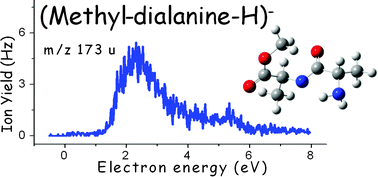Electron attachment to the dipeptide dialanine: influence of methylation on site selective dissociation reactions
Abstract
Gas phase dissociative

* Corresponding authors
a
Institut für Ionenphysik und Angewandte Physik and Center of Molecular Biosciences Innsbruck, Universität Innsbruck, Technikerstr. 25, A-6020 Innsbruck, Austria
E-mail:
Stephan.Denifl@uibk.ac.at
b
Laboratório de Colisões Atómicas e Moleculares, CEFITEC, Departamento de Física, Faculdade de Ciências e Tecnologia, Universidade Nova de Lisboa, 2829-516 Caparica, Portugal
E-mail:
plimaovieira@fct.unl.pt
Gas phase dissociative

 Please wait while we load your content...
Something went wrong. Try again?
Please wait while we load your content...
Something went wrong. Try again?
B. Puschnigg, S. E. Huber, M. Probst, K. Tanzer, V. Vizcaino, F. Ferreira da Silva, P. Scheier, P. Limão-Vieira and S. Denifl, Phys. Chem. Chem. Phys., 2013, 15, 3834 DOI: 10.1039/C3CP44230F
To request permission to reproduce material from this article, please go to the Copyright Clearance Center request page.
If you are an author contributing to an RSC publication, you do not need to request permission provided correct acknowledgement is given.
If you are the author of this article, you do not need to request permission to reproduce figures and diagrams provided correct acknowledgement is given. If you want to reproduce the whole article in a third-party publication (excluding your thesis/dissertation for which permission is not required) please go to the Copyright Clearance Center request page.
Read more about how to correctly acknowledge RSC content.
 Fetching data from CrossRef.
Fetching data from CrossRef.
This may take some time to load.
Loading related content
